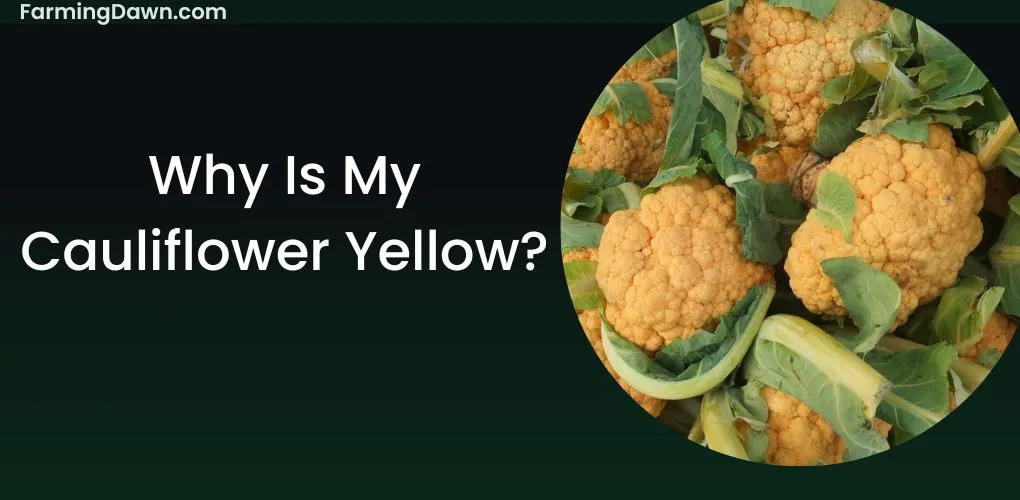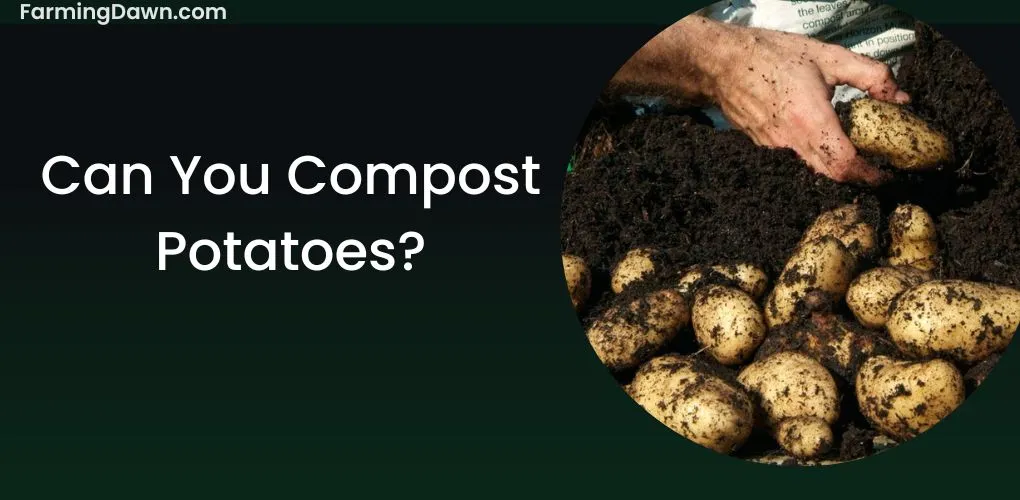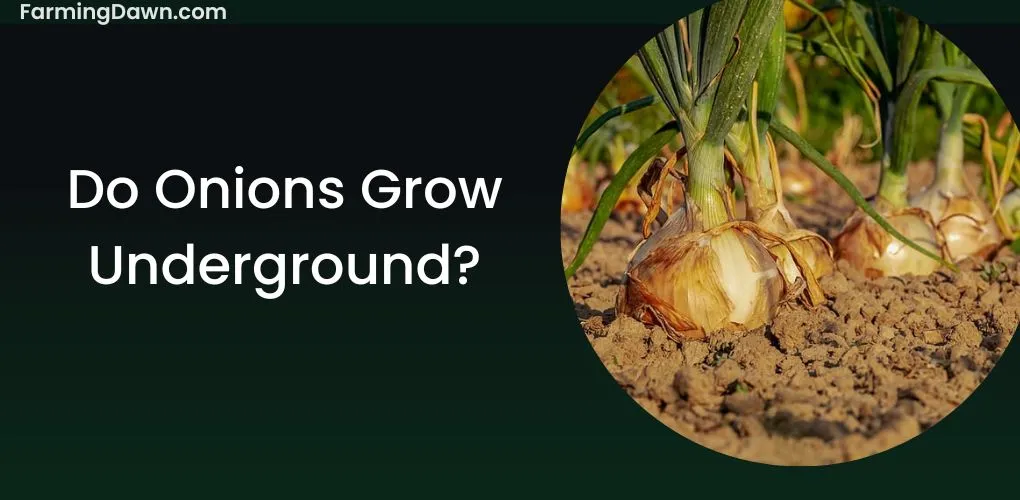Even though cauliflower is a versatile vegetable famous for its white “curd” or head, sometimes you might have observed your cauliflower turning yellow. Many gardeners and home cooks may find this a confusing and worrying situation.
Why is my cauliflower yellow? Today I will examine the causes of cauliflower leaves turning yellow and what you may do to avoid it. I will also share some tips on the phenomenal development of this plant.
Why is My Cauliflower Yellow? Causes
The common appearance of cauliflower
The usual appearance of a cauliflower head is white and resembles a densely packed cluster of flowers. The head is enveloped in thick, emerald-green leaves that protect it from light and keep the flavor and texture intact.
The head is firm to the touch, weighs between one and four pounds, and ranges in size from small to large. The curd’s crisp, somewhat crunchy texture and versatility make it a common ingredient in many cuisines.
Causes of Cauliflower Turning Yellow
Yellow cauliflower can be caused by a variety of factors, including
- Genetics
- Age
- Sunlight exposure
- and Nutrient deficiencies.
Some varieties of cauliflower naturally produce yellow heads, but for others, the yellowing can occur as the plant ages or if it is not getting enough nutrients, particularly nitrogen.
Over-maturity
The plant becomes over-mature when it keeps growing after the best time to harvest it, which leads to the breakdown of the chlorophyll in the florets and the production of yellow pigments.
Over-maturity can produce florets that are stiff, fibrous, and less palatable in flavor and texture. It’s crucial to harvest the cauliflower head while it’s still white, tight, and compact to prevent over-maturity and yellowing.
Depending on the species, this usually happens when the head is between 6 and 8 inches in diameter. You can enjoy fresh, tender florets full of flavor and nutrition by harvesting the cauliflower at the appropriate time.
Nutrient deficiencies
Yellowing of the leaves can also occur due to a lack of essential nutrients like nitrogen, phosphorus, or potassium. Nitrogen is essential for plant development and the synthesis of chlorophyll.
The pigment is responsible for the green color of leaves. While potassium is crucial for controlling water and coping with stress, phosphorus is required to grow roots and flowers.
Reduced yields, slowed growth, and yellowing of the leaves may occur if these nutrients are deficient.
Pests and Diseases
The most common pests that attack cauliflower include aphids, caterpillars, and cutworms, which feed on the foliage and stems of the plant.
Yellowing in the cauliflower heads can also be brought on by ailments like downy mildew, clubroot, and black rot.
These ailments impair the plant’s capacity to absorb nutrients from the soil, resulting in stunted and discolored heads. In some circumstances, the heads could even deteriorate totally and get squishy.
Environmental factors
Like all plants, cauliflower is vulnerable to environmental stressors that can result in discoloration and other stress-related symptoms.
One of the most common causes of yellowing in cauliflower is exposure to excess light, which can cause the plant to produce too much chlorophyll, resulting in a yellowish appearance.
High heat, drought, nutrient deficits, and illness are additional environmental conditions that can cause yellowing.
Yellowing may occasionally be a symptom of underlying problems with the plant’s growing environment, such as poor soil quality, insufficient irrigation, or ineffective pest control.
How to Prevent Cauliflower Leaves Turning Yellow?
You can perform the following steps to prevent cauliflower leaves from turning yellow:
- Tie the Leaves Over Its Head
- Proper soil moisture
- Adequate sunlight
- Fertilizing
- Proper Spacing
- Pest control
- Provide Shade
- Harvest at the appropriate time
Tie the Leaves Over Its Head
Tying the leaves over the head of a cauliflower plant has been shown to prevent yellowing of the head.
This technique prevents chlorophyll, which can cause yellowing, thus blocking out sunlight from reaching the head of the plant.
The plant’s head stays white and fresh while being shielded from sunscald by the leaves tied over it. You can use this method by gently drawing the outer leaves over the plant’s head and tying them at the base.
Just enough tension should be applied to the tie to hold the leaves in place without damaging the plant.
Proper soil moisture
Give the soil the right amount of moisture; while cauliflower needs consistent hydration to grow healthily, it’s also crucial to avoid overwatering the plant.
Overwatering can result in root rot, which can turn the plant’s leaves yellow and make them wilt. Make sure the soil has a consistent moisture level but is not soggy to avoid this.
Adequate sunlight
A sufficient amount of sunlight: Cauliflower requires at least 6 hours of direct sunlight each day to develop healthily.
The plant leaves will turn yellow and become stunted if it does not receive enough sunshine. Place your cauliflower plants in a location that receives lots of sunlight.
Fertilizing
Regular fertilizing is essential for the success of cauliflower plants. Pick a fertilizer high in nitrogen and other vital nutrients, then apply it per the directions provided by the manufacturer.
The plant’s leaves will become yellow and will get stunted if it lacks nourishment.
Proper Spacing
An adequate amount of room is required for cauliflower plants to grow effectively.
The plants will compete with one another for sunshine, water, and nutrients if they are too close together, which may result in the leaves becoming yellow.
A minimum of 18 inches should separate your cauliflower plants from one another.
Pest control
Pests like aphids, caterpillars, and mites can harm your cauliflower plants by causing yellowing of the leaves and other issues.
Check your plants frequently for pest damage and, if necessary, spray them with the proper pesticide.
Maintaining ideal growing conditions
To maintain ideal growing conditions for cauliflower, it is essential to ensure that the soil is rich in nitrogen and other essential nutrients and to keep the plant well-watered.
It’s also essential to maintain proper temperatures because cauliflower favors cool climates.
Additionally, limiting the amount of direct sunshine the plant receives can prevent yellowing because too much light might stress the plant.
How to Keep Cauliflower White During Growing?
Cauliflower grows best in cool climates, so plant it in the spring or fall when temperatures range from 50 to 80 degrees Fahrenheit. The head may turn yellow or brown in warmer climates.
Provide Shade
When the cauliflower head begins to form, cover it with a piece of cardboard or a shading cloth. It will remain white and be shielded from the light by doing this.
Avoid Nitrogen Overfertilization
Nitrogen overfertilization can make the head of the cauliflower yellow. Use a balanced fertilizer and follow the guidelines when applying it.
When to Harvest
Cauliflower should be harvested when the head is still firm and white. It might start to yellow and become rough if you wait too long.
How Long Can I Store My Cauliflower?
Cauliflower can last several weeks when kept in the refrigerator. But how long it may be stored can vary depending on several factors, such as the temperature, humidity, and how fresh the cauliflower was when it was purchased.
Generally speaking, cauliflower should be consumed within 5-7 days of purchase to ensure maximum freshness and flavor.
To extend the shelf life of cauliflower, store it in the refrigerator in an airtight container, away from produce that emits ethylene.
If the cauliflower exhibits any decaying symptoms, such as brown spots or a pungent odor, it is advised to toss it.
What To Do With Cauliflower Turned Yellow?
Cooking yellow cauliflower by roasting is a straightforward and time-tested method.
Cut the florets into bite-sized pieces, mix with olive oil, salt, and pepper, and bake in a hot oven (400°F) for 20 to 25 minutes or until soft and golden.
Stir-fry it
For a quick and simple weeknight dinner, cut yellow cauliflower into small florets and stir-fry in a hot wok with your favorite seasonings and veggies.
Grill it
You can give yellow cauliflower a smoky, char-grilled flavor by grilling it. Simply sprinkle the florets with olive oil, salt, and pepper, then grill them until they are soft and have developed a faint sear.
Mashing Cauliflower
Try mashing yellow cauliflower for a creamy and tasty side dish as a healthier alternative to mashed potatoes. Add some garlic, olive oil, and dairy or non-dairy milk.
Add it to the soup
Yellow cauliflower brightens any soup or stew with color and nutrients. Just break it up into bite-sized pieces and add them to the saucepan and the rest of your ingredients.
After cooking in the liquid, it will become tasty and tender.
Can You Eat Overripe Cauliflower?
Yes, you can eat overripe cauliflower. The flavor could be strong and might not have the same crisp texture as fresh cauliflower.
However, it can still be used in prepared foods like soups, stews, and casseroles, where the texture and flavor won’t be as pronounced.
Furthermore, overripe cauliflower could contain more naturally occurring sugars, giving meals a faintly sweet flavor. It is better to throw away cauliflower if it is moldy or smells bad.
What Is A Self-Blanching Cauliflower Variety?
A self-blanching cauliflower variety is a cauliflower plant that does not require manual blanching to produce white, tender heads.
This is because when the leaves naturally develop, they cover and shield the head, which causes it to turn white as the plant ages.
Both farmers and home gardeners prefer this feature since it not only reduces time and labor requirements in the garden but also produces a more attractive and consistent head.
Self-blanching kinds offer a visually pleasing alternative for any dish in conventional white and fresh, colorful veggies like green, purple, and orange.
Comparison of White, Orange, Green & Purple Cauliflower
White cauliflower
White cauliflower is the most popular type and has a traditional, mild flavor and a soft, crisp texture. It works well in a number of cuisines and is ideal for roasting, steaming, or stir-frying.
Large, dense heads of white cauliflower can weigh up to four pounds and are well renowned for this characteristic.
Orange Cauliflower
This newer cultivar is becoming more and more well-liked due to its vibrant color and sweet, nutty flavor. Its orange color comes from a higher concentration of beta-carotene than white cauliflower.
Adding a splash of color to your meal is easy with orange cauliflower, which is perfect for roasting or steaming.
Green Cauliflower
Broccoflower, commonly known as green cauliflower, is a hybrid vegetable made from broccoli and cauliflower. Both the flavor and texture are delicate, sweet, and crisp.
The healthiest ways to consume green cauliflower are raw or cooked, and it’s a delicious way to get more greens in your diet.
Purple Cauliflower
A special kind of cauliflower, purple cauliflower has a sweet, nutty flavor and a soft, crisp texture. Anthocyanins, potent antioxidants, give it its rich purple hue.
Purple cauliflower adds a lovely color to raw vegetable plates and looks stunning as a garnish on stews and soups.
Why is My Cauliflower Yellow? Takeaway
To conclude this topic, I would say that there are a variety of causes for the yellowing of cauliflower heads, including over-maturity, a lack of water, or stress.
But the good news is that yellow cauliflower may still be utilized in various recipes and is safe to consume, just like its white version.
I hope the information I provided helped you solve the riddle of the yellow cauliflower. If you still have any questions, ask me in the comments. Thank you!
Each plant has its growth habit and harvest time. Read my other articles to learn more:
- Why are My Tomato Leaves Turning White?
- How To grow sweet Peas in Toilet Rolls?
- 2023 Sweet Pea Support Ideas






